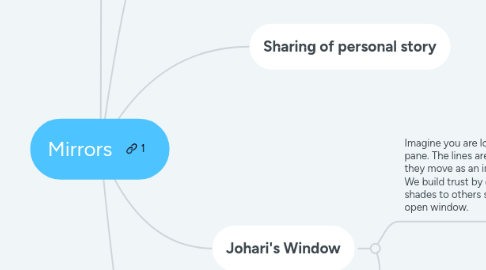
1. Story
1.1. Carnival mirrors distort our reflections, exaggerating our features. Sometimes it's a small distortion, other times it's an obvious one.
1.1.1. Which one are you?
1.1.1.1. We are neither the image, nor the reflection. We are the one standing in front of the mirror.
1.1.1.1.1. It's important to not that people can see you, the mirror and the reflection. They can sense whether it's accurate.
2. Conversation starter
2.1. Think of a leader who portrays an image of themselves who is not who they are.
2.1.1. Why would you follow a leader? What are our expectations of them?
2.1.1.1. Inspire Trust
2.1.1.1.1. By having integrity
2.1.1.1.2. By being competent
2.1.1.2. Knowledge
2.1.1.3. Results
2.1.2. What makes you think they are not who they say they are?
2.1.2.1. What would you have expected them to do differently?
2.1.3. What is the consequence?
2.1.3.1. How does this shape your view of them?
2.1.3.2. How does this affect your trust?
2.1.3.3. How does this affect their influence?
2.2. When you are not comfortable, or accurately presenting who you are, people can sense this and will eventually see it.
2.2.1. This brings us to the topic of integrity.
2.2.1.1. Integrity does not mean to have perfect character; but it means you're not hypocritical. When we are comfortable with acknowledging who we are, the image we project is authentic, and our relationships are stronger, we can be better leaders, hosts, listeners, connectors.
2.2.1.1.1. If we are not comfortable with who we are, we can project an image of who we want to be - and instead we lead with our insecurities.
2.2.1.1.2. People will determine if you are genuine by your if your values, words, actions, and results align.
3. Sharing of personal story
4. Johari's Window
4.1. Imagine you are looking into a window pane. The lines are like window shares, they move as an interaction progresses. We build trust by opening our personal shades to others so that we become an open window.
4.1.1. Open Area
4.1.1.1. What we know about ourselves, and what others know about us
4.1.2. Blind Spot
4.1.2.1. Things we don't know about ourselves but others do
4.1.3. Hidden area
4.1.3.1. Things we know about ourselves but other's don't know. When we open this window to share/reveal, we invite others in. Disclosure builds trust.
4.1.4. Unknown
4.1.4.1. Things we don't know and you don't know. This is an area of mutual discovery, collaboration and surprise. The future is here. We discover through interaction and experiences.
4.2. Exercise
4.2.1. How different are your three areas?
4.2.2. What surprised you?
4.2.3. Why do you think others see you that way?
4.2.4. How can having a larger open area be beneficial to you?
5. Summary
5.1. Integrity means who we are, who we say we are is genuine
5.2. We don't have to be perfect, but we need to acknowledge who we are to be authentic
5.3. When we are authentic, the relationships we build and how we connect with people are authentic, and we gain trust.
5.3.1. Trust is the first step in establishing your leadership.

